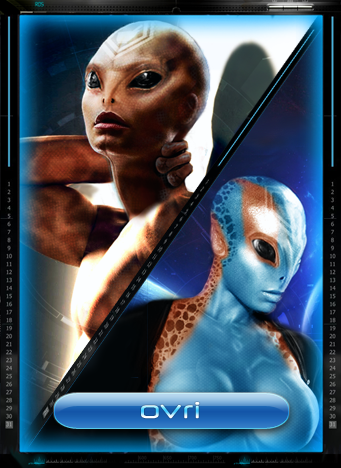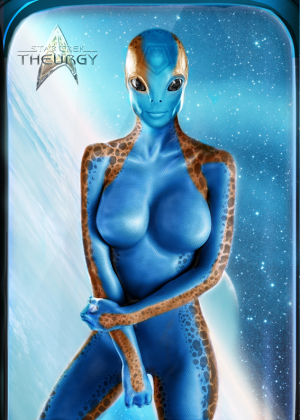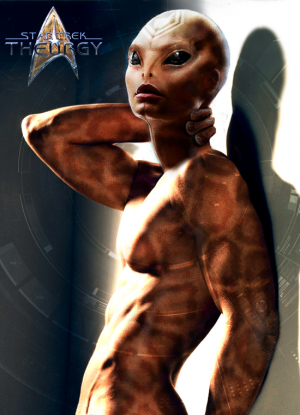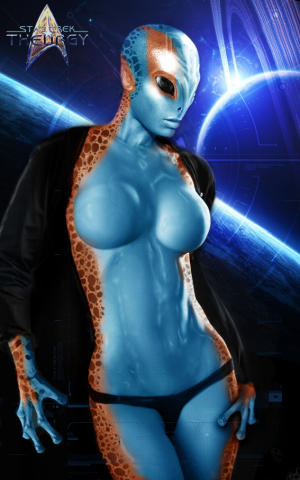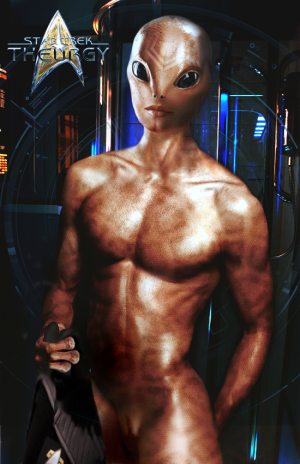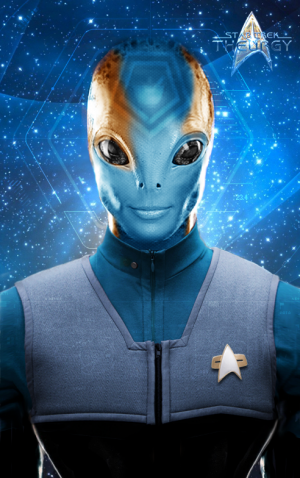Ovri
From Star Trek: Theurgy Wiki
The Ovri, in the old tongue of their race meant "Child of Ice", they were a recent member race to the Federation from a distant system and were very distinct in their appearance. They were a hairless, bipedal humanoid species with digitigrade legs. They originated from a tropical world that had their natural habitat being more amphibious, spending time living both in and outside of water - this origin shows in their slightly webbed fingers and toes - yet as their species expanded into the stars, they came to adapt themselves to space-faring life and survival in more arid environments.
To other species, Ovri also stood out due to their seemingly reversed sexual dimorphism with the females having more traditionally masculine torsos and the males having seemingly feminine traits. Ovri also held a more colorful pallet to their slightly scaled skin, almost like poison dart frogs on Earth. They were - in general - a peaceful race who avoided conflicts, which made them exceptional diplomats, mediators, counselors, and medical practitioners when dealing with other races. This also tied into their approach to war, not seeking direct conflict. They would attack a situation from the side, coming in with alternate means to achieve their goals without sacrificing lives on their side.
Physiology
Ovri were warm-blooded, but their bodies generally lacked the ability to retain heat very well. However, they did possess the ability to enter a hibernating state and freeze their bodies. The hibernation state was an unusual trait, but with the sudden and harsh winters of their world, it proved an invaluable adaption. Ovri also possessed regenerative abilities; a lost finger could be regrown in a month, a lost limb in a year or so, but they handled open wounds very poorly and it remained common practice for their people to hack off an injured limb and let it regrow instead of repairing the injury and waiting for that to heal, as broken bones took multiple years to fully mend. Ovri possessed no hair on their bodies either, while males were colorful in appearance. The females lack such pallets and tended to have more muddy and dark color pallets that benefit natural camouflage.
Females of the race, despite their more masculine appearances, still possessed vaginas. Their vaginas were internalized and appeared flat and smooth when not aroused, when aroused they puffed out slightly with increased blood flow. Males possessed faux breasts which were believed to show that they were healthy and well-fed, these traits helped them acquire mates in primitive times. Male cocks like the female vaginas were internalized, pulled back into the body when not in use, but when aroused, they popped out and grew to a fully erect state. The male genitalia was fully internalized due to their lower body temperatures, making it so their testicles were safe inside the body. Ovri penises had a bulbous, segmented look that came out to a tapered tip. The segmented cock allowed them more control over the cock, and they also secreted a natural lubrication over their length when aroused.
Ovri produced a powerful mix of pheromones in their mouths, in wet conditions small amounts are secreted from their skin, so if an Ovri were dry, they could still procure a mate. Females had a kiss they could perform to pass off the chemicals and arouse their mate. Males possessed many attractive scents, while females held more complex scents that proved confusing and repulsive to predators.
Instead of teeth, Ovri had a hard band where their teeth would be, it was usually under their stiff gums, but when needed, they pushed it out and clamped down with many tiny sharp points. Their tongue was also very long and elastic, not able to be launched to catch prey, but capable of extreme dexterity that enabled an Ovri to do things like push into a cramped space to grab prey. Ovri had the ability to hold their breath for extended periods of time. Their natural hunting grounds were the warm shallow waters of their planet, where their webbed hands and feet allowed for a bit more speed when swimming. However, they were not the fastest while swimming, mainly having quick short bursts of speed underwater and a focus on mobility, mostly using their hands to pull themselves along while looking for food.
Their skin was elastic and kept moist to allow their protective measures to work more rapidly, but outside of their ideal environments and worlds, Ovri had dry skin like a human's, but seemingly comprised of small scales. Their joints, like elbows and knees, become distinctly scaly in a dry state. When dried out further, their skin toughened up and flaked, but it would not result in a fatal dehydration, only skin damage, this was a result of a push by their scientific minds to introduce a trait that would allow their people to be more adaptive. The trait was created and given to all members of the race though a stern program with those that suffered side effects from the modification dying off, leaving only those that adapted. Their skin was also resistant to most fires. With its high water content and adaptive nature, they could be exposed to fire much longer than a human before burning or blistering.
Their large eyes were very sensitive and detected things slightly beyond the standard visible spectrum into the ultraviolet. Their eyes did, however, have two separate eyelids, one was a transparent membrane that protected the eye while swimming, the second covered the eye and blocked out light. But due to some sensitivity problems around brightly lit ships, the use of synthetic lenses applied to the eye was done when dealing with other races.
Physically, the Ovri were more powerful in their legs. Their arms, however, had many strong, fibrous tendons that allowed for more strength when holding things and strong gripping of their surroundings so their legs could push them along. Their bones were like human bones in strength, but like the rest of their bodies, if it took damage it was better to just remove the damage than to let it recover. Ovri had four fingers with webbing halfway up their hands, their fingertips were larger with deep distinct prints to allow better gripping of objects.
An Ovri normally lived anywhere between 80-100 earth years before dying of old age, but an Ovri who was frozen at any point in their life had a lifespan that was usually a decade longer on average. As a result, their regenerative powers worked at a slower rate. Hibernation was not an answer to immortality though, as years began to pass, cell structure could begin to break down.
Psychology
Psychological norms for the Ovri showed a more relaxed race, there was little need for conflict, and their less aggressive members were usually the ones that survived through evolution. They were generally kind and understanding, they had a strong sense of community and unity, but their scientists learned over the years that they needed to be competitive, so children were conditioned to compete and strive. Generally peaceful, they did not seek conflict but avoided it. They often went at problems sideways, instead of doing something to remove a problem, they instead choose to adapt. They were also very humble, choosing to leave as small a footprint as possible where they went, not thinking they had any right to take things.
Not only is there some confusion regarding the seeming Ovri reversed sexual dimorphism by some Federation personnel, there is also a lack of understanding when it comes to their understanding of physical intimacy. They don't generally have an issue with casual sex. And while not universal they tend to be both pansexual and polyamorous.
However, there are those who want a deeper level of intimacy. An emotional one.it is not uncommon for them to choose to live in a monogamous relationship. Those who chose to do so become bonded to each other. Bonding is similar to Terran marriage. Like marriage, two, or in some cases three partners make a commitment to each other.
There is an added layer to Ovri bonding that goes beyond marriage. The partners involved engage in a mutual sharing of pheromones over a seventy-two hour period. This sharing cements the relationship.
Rather than exchanging rings, the partners exchange matching tattoos, on either the opposite cheek, neck or forearm.
Language
The dominant Ovri language was known as Kreepip, it was a developed language formed from the mixing of the different languages on their home planet, refined over generations into a final form. It used mostly sounds made from the deep throat and clicking of the tongue. Their written language was based around circles, there were 32 "letters" in their alphabet. To form a word they wrote from the bottom left of a page then upwards. Words were composed of linked circles, spaces between them showed where a word ended, and when they reached the top of the page they started a new column to the right of the last one. Their writing looked like a series of bubbles with different things inside each circle, ranging from geometric shapes to lines.
Their vocal abilities had a vast range. Music was one of their greatest skills for a long time. Ovri had their usual ranges, but if needed they could strain their vocals to make louder sounds with loud croaks or sharp chirps.
Home World
The Ovri homeworld was known as Qworthrik, in English, this roughly meant "Stone Mother". It was a planet covered in 83% water; most landmasses were like the amazon with tall trees and saw a lot of rain. The only land that was not like this was usually mountainous and dry, but rich in metal deposits. The planet was slightly smaller than earth and had a smaller core, thus their gravity was lower, the planet also had a north and south pole that were frozen like on earth, although smaller and more prone to change in size from decade to decade. The landmasses did form five main continents that had natural land bridges during ice ages on the planet.
Culture & Customs
Ovri culture and customs were different. Their culture was primarily a Patriarchy, but things were much more open. Females were allowed breeding choice for each clutch. Females looked after their children while males treated all children as if they were their own and would act to protect them at all costs. As they bettered themselves, the patriarchy formed councils of the men to lead and plan things out since males tended to excel at these tasks, while females took care of the land and hard labor with their more toned bodies. Eventually, they formed more equal councils. Men made the laws between trade and business while females governed the land and its use. All inheritance was followed through the mother's line since males were less likely to look after their own children. Thus, the inheritance of a family was passed down from mother to daughter. Males could own land as well but often lived with their mate. If their mating relationship ended, they would move on and provided housing of their own.
At one point there were many males that were dedicated to simply mating. These individuals were looked back upon by Ovri historians and considered a blight and were sighted as why task signs were created. They would be stained into the skin of every man and woman, indicating their greatest skill, and the color would tie them to a guild, this way people knew what you did and where you worked before mating with you, putting less value on physical appearance and more on skills and knowledge. When the colonies were founded, the marks were surrounded by shapes indicating the planet of origin. (Homeworld a circle, first colony a half-circle, second an oval, third a triangle, fourth a square, and so on up to 17)
With the Ovri, it was customary to remain silent in the presence of superiors and elders, but when appropriate, it was expected of the young to question and suggest. The mind was considered a valuable resource and the young thought to carry new ideas. Due to their regenerative abilities, the Ovri never worried much about trauma and cared little about recovery, but did care about new growth, new beginnings, and forgiveness. As their philosophers stated, "A gash will heal slowly, it is best to remove it and begin again. Let go of the past and begin again, learn from your mistakes, do not let them linger."
As Ovri moved into the modern era, the basic format of an Ovri family fell apart, and mass communities of children were formed, looked after by specialized teachers and caretakers. Among Ovri, abortion was rare due to the lack of personal responsibility and investment needed from either parent. As such, clutches were the closest family most Ovri had, and a clutch was often set to compete among themselves to decide where they went in life and encouraged competition at an early age.
History
The Ovri are a relatively young race, all things considered. They were a very thinly spread out race in the beginning. When their race started to form civilizations, their planet was seeing extreme winters that froze the planet except for around the equator of the planet where a lush jungle was located. However, as time went on, the planet thawed and the ice receded, causing populations to become separated and isolated from one another. Over time, there was less and less ice until it only existed in the furthest reaches of the planet. The forest at the equator spread quickly where the ice had once covered and soon the world was covered in Amazon-like forests with many rivers, lakes, and the vast oceans. Their people thrived along the rivers, eating the animals that lived in the waters. The humid weather allowed them to live almost anywhere on the land, but the generally open nature of the oceans made crossing them a challenge in the beginning as Ovri never remained in the direct sunlight or salty air for too long.
When the Ovri moved from their homelands and explored their world, they encountered others of their own race and peace followed with surprising ease due to the cultural similarities. Although separated, they each shard the same basis and their world unified quickly and soon began to advance. They pushed into an industrial revolution that quickly moved into a modern era and into the birth of their space-faring beginnings. But as they were about to make their first mission to attempt constructing a moon base, they happened across another race, a race unknown to the Federation. This ship abducted and experimented upon Ovri civilians, and it had remained undetected if not the abductees had managed to contact their home planet.
Although outmatched by the superior technology of the alien race, Ovri sacrifice and ingenuity were used to win. Through scanning the ship was seen to have a weakness, using chemical weapons the Ovri caused the ships hull to weaken and break. Then to bring the ship down, a passenger ship was loaded with a nuclear generator that had been modified into a bomb. Without hesitation the ship rammed the compromised hull of the alien craft, destroying a decent portion of it and killing the crew within. To ensure any ship that might follow the first one would not find them without defenses, the Ovri acted quickly. The Ovri quickly introduced the new technical discoveries made from the ship, adopting a more driven perspective and casting off their more pleasure-seeking ways. With the events of the encounter burned into the public memory, the Ovri swore to spread into the universe as they had across their own planet, with peace and open arms.
Spreading out and encountered the odd merchant and trader now and then, but found that their space was mostly uninhabited. Whenever they found something new technologically, they took it and adapted it into their own culture. Soon they had gone out so far they decided to claim territory and begin colonizing planets. They quickly grabbed up planets and put down colonies, eventually genetically modifying themselves to survive in new varied environments. But in their rush, they accidentally began a series of events that almost wiped out the basic life on a few of the planets they had colonized. This led to much debate and the conclusion that they did not need to take planets for themselves. This began their preference to take asteroids instead. Forming bases and stations, their people made entire cities in space.
After some time and a few small border disputes with other races had passed, they began to explore again and ended up encountering a Federation patrol and their diplomatic relations began. It was slow and seen as a distant relationship, but the Ovri invested all the same as the opportunity to join a galactic community was too precious to pass up. To show their dedication, they took the top graduates of several of their fields and sent them to join Starfleet. Stepping their best foot forward, they would show what they could do and hope to build friendships with many more races. They did, however, keep their relaxed policy of genetic testing and modification to themselves and never mentioned how much they had changed their genetics.
Government & Military
The Ovri planetary government was known as the "Grand Council". It was composed of the heads of every one of the major fields. The grand council voted on laws and policies that pertained to the planet, they decided where things should go, and what needed to be done. They did not cover local laws.
Local laws were made by the guilds. The guilds were formed by an expert in each field (medicine, technology, communications, etc.). This way, the experts in a field dictated its laws and operations. If they created laws that interfered with the overall unity or used them to grab power, the other guilds took votes to overthrow a law from another guild. This was run on smaller scales in independent cities and stations. In the overarching community as a whole, if a planet or a city was being mismanaged by its guilds, a Planetary Council was called and the mismanaged location was given a month to shape up. If it failed to fix itself, their leaders were removed and a new council was formed.
As for a military, the Ovri had no need for one aside from a group known as "The Spears", a well-trained task group trained in dealing with violence and danger. They started as the ones who kept roads clear of bandits and wild beasts, then they became the police force. When they encountered their first alien race, they were restructured into several new branches. The Spears remained the police force, but there was also the new groups known as "The Fist" and "Threat Management". The Fist was the direct military, trained troops with genetic modification for tougher hides upon enlisting. Their job was to deal with battles that The Spears were not equipped for. Threat Management was the covert operations portion. Often comprised of highly modified individuals, they were created to infiltrate and eliminate targets; they would be deployed before or during conflicts to eliminate leaders or major threats. They mastered sabotage, toxins, and stealth. They would never fight face to face, always laying traps or performing ranged kills.
Their Navy was similar in structure. They had Merchants and commercial crafts, and then they had scouting and exploration vessels. Usually, they carried scientists, negotiators, and a company of Fists. After they explored a region, other ships were sent, anything from a science craft to construction frigates. When conflict arose, they deployed combat ships. Combat ships had three tactics of combat. There were scare tactics, where they came in and drove off a threat, confrontation tactics where they fought to destroy an enemy, and then disabling tactics where they removed a threat so peace might be obtained. Then there were stealth and trap ships. A trap ship was a re-purposed cargo vessel filled with a seemingly harmless environment and left with a dead drive. These ships were deployed where enemies and pirates appeared. Once boarded, anyone who entered a trap ship and opened doors would submit themselves to a mix of, on their own, harmless toxins, but once mixed, they killed their invaders. Due to the harmful indiscriminate nature of these ships, they were only used in the direst of situations. They went so far as to convert stations and once an entire city into such a trap. Stealth ships were always operated by Threat Management. These ships infiltrated hostile territory and lay in wait for their targets, laying traps and launching surprise attacks. They were also are used as deployment points for Threat Management teams to work from.
Technology
Ovri technology was strange as well. Due to their trade policies and encounters, Ovri focused much of their time on shields and stealth. They were not as good as the Federation's, but they had very good cloaks that followed the phasing design. Ovri shields could be sustained at a much larger size and with high efficiency. Ovri did not have advanced replicator and transporter tech; transporters needed to have a closer range to work, and their replicators needed base materials to construct items from. They had hologram technology used in different ways; it was used in unison with cloaking to hide ships and weapons. With weaponry, the Ovri had many different types. Their own people's weapons only got as advanced as projectiles and rockets before they met new races. Then they adopted plasma-based weaponry which became their basic weaponry. They also obtained beam cannons later on and matter accelerator cannons. To have something of their own, Threat Management developed pulse weapons designed to overload and fry ship systems, combined with phase cloaks the pulse weapons were often drifted towards threats and then activated.
Ovri medical studies had different focuses than those of the Federation. Implants and trauma treatment were a very low priority and not well researched, while biomechanics, genetics, and other similar fields were excelled in. Most genetic diseases were mapped out and rectified.
As for ship systems, the Ovri ran their ships with computers and inorganic conduits. They had crystal-based systems and used a warp drive less powerful than that of the Federation, but they had fewer flaws and ran much more safely. Ovri did not have much for terraforming, but they had very good station construction and stabilizing systems as well as fission reactors to power their systems. Ovri also had a high level of tech invested in thermal research, to keep things at a level their people could survive and have outfits to keep them alive. This also made their stations hard to find as they often gave off no heat signatures and remained hidden without the use of cloaking.
Mythology
Dominant Ovri Mythology claimed that the Ovri were born of the ice. Their creator, the Stone Mother, created many children on her world before the Ovri, all beautiful and unique, but the Stone Mother had a lover - the Ice Father - and he gave her a cloak of ice as a gift. But as the icy cloak covered the land, the children perished from the harsh cold. Saddened by the loss of her children, the mother wept into the snow and ice. Her tears froze and formed into the first Ovri. Distraught over his actions, the Ice Father pulled his cloak away, allowing spring to come and wake the Ovri who thawed and emerged. Overjoyed with her new children, the Stone Mother gave them a home over her chest, where the forests were formed. However, as the cloak was pulled away, it brought the seas and the rain. Fearfully, the Stone Mother moved her children to the land on her body, separating them, but keeping them alive.
Other tales spoke of the Father returning to see the children and how he froze them again. Seeing his harm, the father left and though he promised not to abandon his children, he would not return to harm them again, remaining to the distant north and south and atop the windy mountains.
The Ovri had a legend known as the noble brothers. Saddened that he could not see his children with the Stone Mother, the Ice Father asked for his brothers to keep him company and to help look after his children. So his three brothers went to watch over his children, circling the world and telling the Father of their progress. The Bothers were always there in the heavens, always watching and circling their brother's mate protecting his children. This legend spoke of the three moons that orbited the home planet of the Ovri.
After these myths came those of the grand heroes. Stories of children of the moon gods, of people made by the Father of Ice and born from the depths of the Stone Mother. Mostly fictional tales of great explorers and fair beings, some related to actual people and groups, as it was later discovered there was once a group of subterranean Ovri, though only their dead were found. It was thought that seismic events that were quite violent in the past drove them above ground, and those that remained below died from toxic gasses and cave-ins. There were some Ovri more resistant to freezing, but they did not adapt well to the warming planet and either integrated into society or died out.
There were various other myths about exotic beasts and monsters but most, if not all, were false or talked about unknown things that happened in the world. But one myth remained important to the people, one they taught and did not speak of outside their society - the myth of the star stoppers. It was believed that in the Ovri's bronze age an asteroid was going to collide with the planet. It would have been sudden; records said that a blinding streak ripped across the sky as if a star was coming to touch their lands. As it was about to come down, it was destroyed in a burst of brilliant violet light. The explosion left very little derbies and it was written off as a myth for ages until several accounts from different areas that had no way to contact each other retold similar accounts and mentioned a spot in the sky that had not been there before, that moved of its own free will and then left as suddenly as it had come. Ovri chose their first five colonies on rather distant planets, planets not ideal for settling, but still, they settled there. Although it was never mentioned, each of the planets had strange relics that were quickly taken and hidden away.
Special Notes
Ovri had several natural predators, the most notable was the Kerrok, found to be one of the oldest words it was the name of an amphibious beast that had a large gaping maw. Kerroks hunted Ovri and swallowed them whole while jumping into the rivers. It was widely believed that Kerroks led to the development of metal weapons and eventually gunpowder to make guns to combat them. Within a span of 100 years, Ovri actually hunted Kerroks to extinction.
The race that saved the Ovri from extinction was on its last leg as they performed their good deed. They left artifacts and messages to the Ovri, nothing tech-based, only encouragement and philosophy of a dying race. However, it was believed that the first colonies found more advanced artifacts that the Ovri used to better themselves.
Ovri homes and stations were based on plant life; they had domed shape and many supporting stalks underneath. This gave them added stability from outside influence.
Ovri mated on a 3-month cycle. This could be extended to a yearly cycle with medication. Their females produced eggs and bulged noticeably, taking on a pregnant look as they became stuffed with eggs. If they mated with a male, they released their eggs into a submerged environment. All eggs turned opaque when left in the water and only 1 in 6 was usually fertilized of a clutch of 24 eggs. Children took five months to hatch and then fully developed underwater for 2 more months. Under their culture, the child was raised by the father and protected while they fully grew up for the next seventeen years, at which time they were considered adults and allowed to choose their future. During those seventeen years, they receive their primary education(which in human terms would be sixth-form or High School. They can then choose to receive a post-secondary education in the vocation of their choice. The competition for his education, especially among the more prestigious Universities can be quite fierce.
The marks on Ovri foreheads were derived from ancient tribal dye markings, using the same ancient plant dyes. Although synthesized with replicators, the marks held ties to ancient Ovri practices to mark one's tribe identity. After the events of first contact, the tradition was revived as a means to distinguish people for their skills and put an end to the pleasure-seeking culture that had been slowly taking hold.
